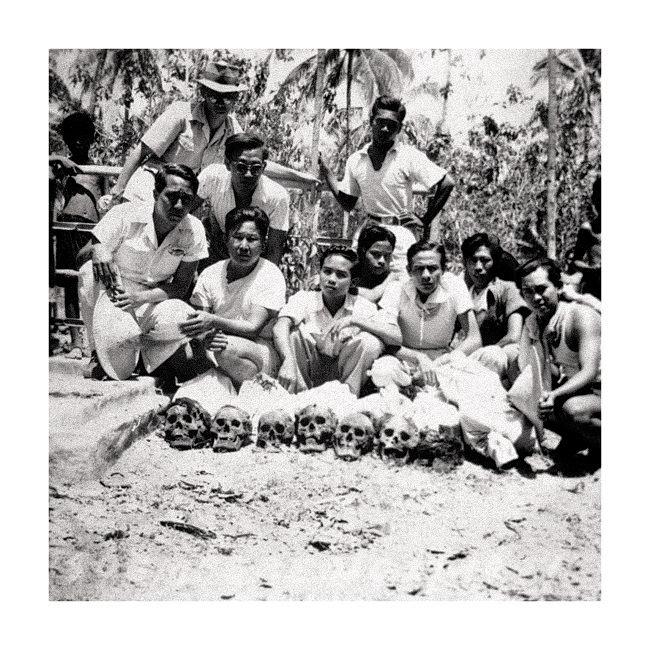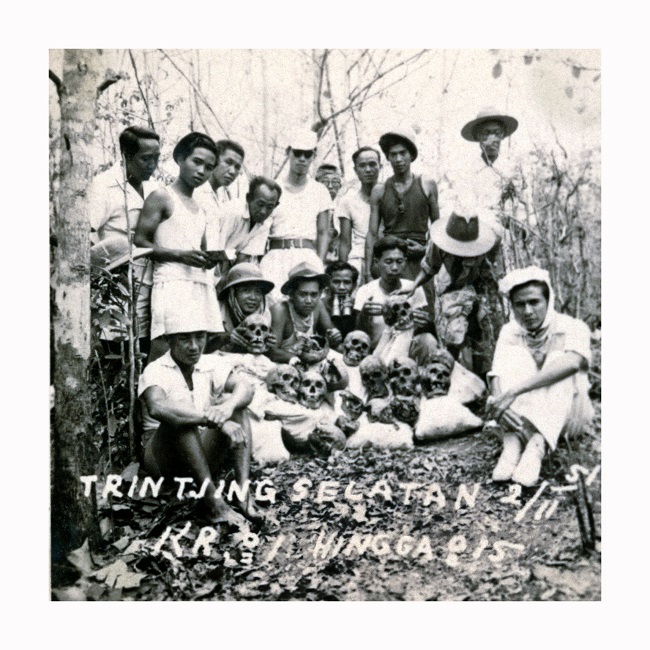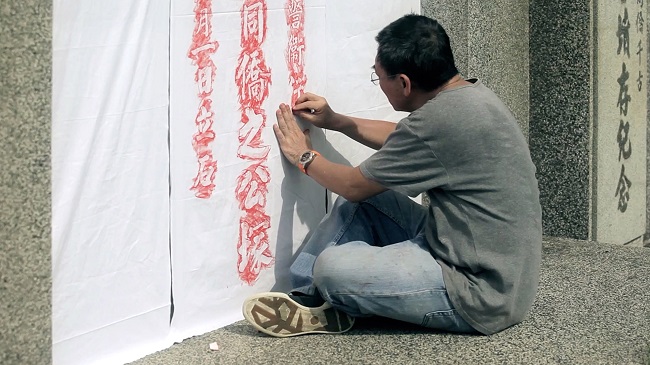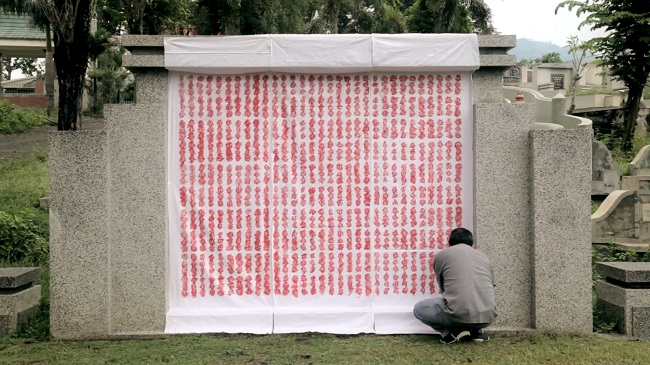Documenting and remembering mass killings of Chinese Indonesians during the Revolutionary war
FX Harsono
When I was in elementary school, I used to flip through a photo album that was tucked away on the shelf in our living room. The album contained photographs of human bones and skulls that had just been dug from the ground. There were about 60 photos, 6x6 cm in size. This was my father’s documentation of the excavation of the corpses of Chinese Indonesians who were killed between 1948 and 1949 in several villages around our home town, Blitar, in East Java, where I was born in 1949.
My father was a photographer. In 1951, he joined a team to find victims of the Chinese massacre in Blitar. This agenda was initiated by the Jakarta branch of a Chinese society called the Chinese General Association or Chung Hua Tsung Hui (CHTH). The search and excavation, which was carried out between October and November 1951, found 191 victims. Their remains were then collected and buried together in a mass grave in the Chinese cemetery in Karangsari Village, Blitar, East Java Province, part of the Kediri district.
Following the Japanese surrender in August 1945, the Dutch returned to Indonesia and launched the so-called first and second ‘police actions’. These attacks on the Republic in July 1947 and December 1948, took place predominantly on the outskirts of cities and in rural areas in Java and also in several cities in Sumatra. In this process, Chinese were forced to cooperate with the Dutch and work as military police, standby troops, and also as spies in a number of regions, particularly in Java.
At that time, the Consulate General of the Republic of China in Batavia, Chiang Chia Tung, opposed the recruitment of Chinese as Dutch collaborators. In a letter addressed to Lieutenant Governor HJ Van Mook and Lieutenant General SH Spoor, he stated that the presence of Chinese troops may create grave misunderstandings between the Indonesian government and Chinese community in Indonesia. He warned that the safety of the Chinese community in other parts of the country may even be put at risk.

In response to the ‘police actions’, the Republican army retreated to the countryside, from where they engaged in guerrilla warfare in the jungles and villages. As they exited the cities, they performed a strategy referred to as ‘bumi hangus’ (scorching the earth) – burning down buildings, factories, and vital infrastructure in their wake. The bumi hangus strategy was accompanied by evacuations of the populations living in the cities. Together with other groups suspected of loyalty to the Dutch, Chinese were forced to leave their homes. Amid this chaos, many Chinese homes were pillaged and Chinese people robbed, the men were taken away to be murdered, and some women and children were also killed.
An artist’s journey
My father’s photos had awakened my instinct as an artist who usually creates works through research. Initially, I planned to conduct research on the issue of discrimination and violence against ethnic Chinese in Indonesia. Based on the photos I found, I continued my exploration. I visited villages and looked for eyewitnesses or survivors. I attended the mass grave at the Chinese cemetery in Karangsari Village, Blitar. I documented all of my activities then compiled it into a film, which I later produced and titled nDudah (2013). In Javanese, ‘ndudah’ means to excavate. The documentary tells the story of the exhumation of the Chinese people who were victims of the mass murder.
I then pursued my research, drawing on the limited data and information collected by Benny G Setiono in his book, Tionghoa dalam Pusaran Politik (Chinese in Political Vortex, 2003), which includes details about the killings, including reference to a memorandum by Kwee Kek Beng, published by the CHTH in Batavia in 1951. Titled in full, ‘MEMORANDUM: Outlining Acts of Violence and Humanity Perpetrated by Indonesia Bands on Innocent Chinese Before and After the Dutch Police Action was Enforced on July 21, 1947’, it is essentially a report on events experienced by Chinese in Java and was later sent to the United Nations.
I began carrying out my own research into the killings in 2009, firstly by visiting the Chinese memorial foundations that usually exist in every city. I then went to the Chinese cemeteries where I searched for clues, assisted by graveyard custodians. At the Chinese monasteries, I looked for people over 70 years old who were born in the area, as they might know more about the local history. My search was very difficult, however, because the people I was looking for either had difficulty remembering, were sick or had already died. Also, if the custodians of the Chinese memorial foundations and cemeteries were themselves born after 1965, they simply had no knowledge of the mass graves.

When I finally had a chance to meet with eyewitnesses or survivors, not all of them wanted to talk about their past. They told me that such a dark history should be forgotten and it was better for the stories to remain untold. They admitted that they had not even told these stories to their own children. They were afraid that doing so would endanger the fate of Chinese Indonesians in the future.
This type of anxiety and ‘shutting-self-off’ attitude is not only expressed with regards to the killings of 1947 to 1949 but also in relation to almost all historical events where Chinese are victims. If no one is willing to tell the story, in the end, this oral history could be erased from the nation’s collective memory.
This attitude reveals enduring political trauma, especially during the New Order regime. Djun Kiem, the grave keeper in Blitar who is featured in my documentary, nDudah (2013), explained how during the Suharto era only a few people made pilgrimages to the mass grave. This changed after Aburrahman Wahid, who is known as Gus Dur, became president in 1999. More people came to pay tribute. During his presidency, from 1999 to 2001, Gus Dur repealed or revised various laws and restrictions on education and citizenship that had discriminated against Chinese Indonesians.
Nonetheless, the fear has not completely disappeared. Most of the respondents I spoke to in the course of my research warned that there are no guarantees that Chinese Indonesians will remain safe and that there will be no discrimination in the future.
Racist riots, whether on a small or large scale, and other threats from the majority against ethnic Chinese Indonesians still occur from time to time. The riot of May 1998, the conviction of Basuki Tjahaja Purnama (Ahok), and the persecution of several ethnic Chinese people in several places in Indonesia on the grounds of religious insult, have confirmed their concern that the government can not protect this minority group against the political and social pressures within society.
Art is pilgrimage
The deletion of history, the feeling of insecurity and threats, as well as long-standing political intimidation have resulted in a loss of trust of authority among Indonesia’s ethnic Chinese community. This is what I want to present in my artwork, without resentment and anger. I interpret this dark history and my creation of works of art as pilgrimage. The pilgrimage for me is an event and at the same time it serves as a very personal ceremony to pay tribute to and show respect for the victims.

During my decade-long research journey from 2009 to 2019, into the killings of Chinese people in Java, I made pilgrimages to ten mass graves. From the gravestones one can count the number of victims buried there: Blitar has 191 victims, Caruban has 69 victims, Kediri has 300 victims, Muntilan has 17 victims, Nganjuk has 788 victims, Pare has 68 victims, Purwokerto has 78 victims, Tulungagung has 73 victims, Wonosobo has 155 victims, and Yogyakarta has 25 victims. The total number of victims is 1764 people.
There are still many victims who have not yet been identified, graves dismantled and damaged, and mass graves still hidden.
In this process of investigation and discovery, I have produced several works of art: Bone Cemetery Monument (2011), Rewriting on the Tomb (2013), nDudah (2013) and two other documentary videos, Pilgrimage to History (2014–2018) and The Last Survivor (2019). It is all a part of the pilgrimage to pay tribute to the victims.
Given that violence and discrimination against ethnic Chinese Indonesians has occurred repeatedly over time, it seems that society has not learnt from history and tends to easily forget incidents that violate human rights. I hope that through these works the audience will acknowledge the history of violence and discrimination towards the Chinese Indonesian community during the revolutionary war, so that this does not happen again.
FX Harsono (fxharsono@gmail.com) is a seminal figure in the Indonesian contemporary art scene. His artistic language meets the current new social and cultural contexts. From 2000, his works are vocally pointing out discrimination experienced by the Chinese minority in Indonesia. FX Harsono studied painting at STSRI ‘ASRI’ (Academy of Indonesian Arts) Yogyakarta and at IKJ (Jakarta Art Institute). He was awarded the 2014 Prince Claus Award, by the Prince Claus Fund Netherlands, and the 2015 Joseph Balestier Award for the Freedom of Art, by the Singapore embassy of the United States of America and Art Stage Singapore.
